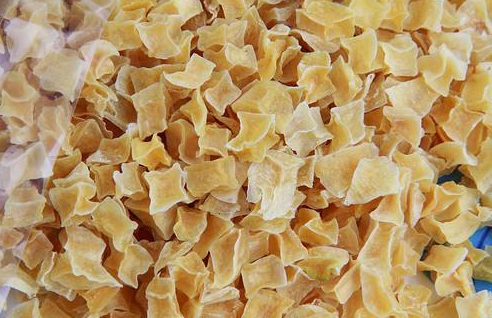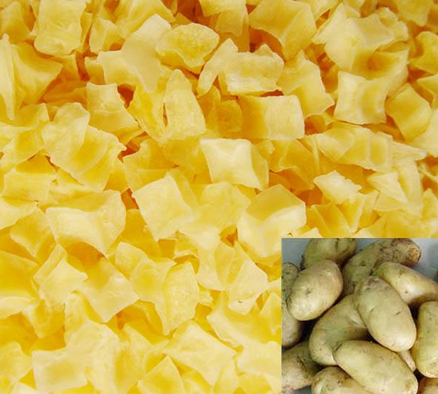Dehydrated potato Ding is a high-quality potato food that is increasingly important in the food market and can be used in a variety of foods such as canned meat, yak meat, frozen meat pies, soups, potato salads, and the like.
Process flow
Potato→cleaning→peeling→dicing→bleaching→cold water washing→chemical treatment→drying→sieving→cooling→packaging
Operation points
(1) Raw materials: When selecting raw materials, the total content of reducing sugars and solids should be determined. In the case of dehydration of potatoes, amino acids and sugars may react and cause browning, so varieties with low reducing sugar content should be used. The raw material with high solid content is made into dehydrated potato diced, which can show excellent performance. The relative densities of various types of potatoes vary widely, and relatively high density raw materials have excellent cooking characteristics.
In addition to the above two factors, it should also consider whether the size and type of the potato are consistent, smooth, and germinated. At the same time, the potato should be cut open to check whether there are different levels of necrosis and other pests and diseases inside, and check its color, smell and taste.
(2) Washing: The potatoes must be cleaned, the soil adhered to them is removed, the contaminated microorganisms are reduced, and the temperature of the potatoes is also favorable. Immediately after cleaning, a preliminary inspection should be carried out to remove potatoes that are not suitable for processing due to slight greening, mildew, mechanical damage or other diseases.
(3) Peeling: Since the potato cannot be processed in time after harvesting, after a period of storage, peeling is difficult, and steam peeling and lye peeling are effective. It is advisable to use steam to peel the skin early in the processing season, unlike the loss of alkali peeling; it is more economical and suitable to use peeling in the later stage.
The use of steam or lye when peeling potatoes often exacerbates the browning. At the edge of the potato, especially the blackening of the reactants around the vascular bundle, it is more concentrated than the other parts. The degree of discoloration depends on the extent to which the potato is exposed to the air. Therefore, the time when the peeled potato is exposed to the air should be minimized, or the surface of the potato should be drenched, or the potato should be immersed in water, so that the discoloration can be reduced. If the discoloration tendency is severe, a reducing compound solution such as sulfur dioxide or sulfite may be used to keep the surface of the potato moist.
(4) Dicer: Before dicing, classify and select unfavorable potato chips. When cleaning, you must pay attention to the exposure time of the potato chips in the air to prevent excessive oxygenation. At the same time, through the water sprayers installed on the conveyor line, the water is continuously sprayed to keep the surface of the potato. Wet.
The potato diced is carried out in a standardized dicing machine. When the potato is fed into the dicing machine, a certain amount of water is added to keep the knife edge moist and clean. The surface of the cut potato must be washed before blanching. The size of the potato diced should be based on the market and the requirements of the consumer.

(5) Blasting: Potato tubers contain a large amount of enzymes, which play an important role in the metabolism of potatoes. Some enzymes can make the surface of the cut potato black, some participate in the change of carbohydrates, and some enzymes decompose the fat in the potato. These enzymes can be destroyed or deactivated by heat or some other means. Blanching also reduces microbial contamination. After the potato diced is cut, it is heated to 94-100 ° C for blanching. The blanching method is carried out in water or steam. When steaming with steam, the potato diced is placed on the hanging belt of the stainless steel conveyor, and more advanced is placed in a screw conveyor to expose it to steam for heating. Under normal circumstances, the soluble solids lost by steam blanching are less than the water blanching, because the soluble solids in the potatoes are dissolved in the water in time.
The blanching time ranges from 2 minutes to 12 minutes, depending on the temperature used, the size of the potato diced, the capacity of the blanching machine, the uniform distribution of heat in the blanching machine, and the potato variety and maturity. The degree of blanching has a significant effect on the texture and appearance of the finished product. Excessive blanching will make the potato soft or mushy. Immediately after blanching, spray water to remove the gelatinous starch on the surface of the potato to prevent it from sticking during dehydration.
(6) Chemical treatment: After the potato is boiled, it should be sprayed immediately with a sulfite solution. Potato diced with sulfite allows higher temperatures to be used during dewatering, which increases the rate of dewatering and the productivity of the plant. Dehydration at higher temperatures produces a loose product, and the product is complex. The water has good performance and can prevent non-enzymatic browning and coking during dehydration, which is beneficial to product storage. However, it should be noted that the water content of the product should not be too high, otherwise the sulfite will be ineffective. The content of sulfur dioxide in the finished product shall not exceed 0.05%.
Calcium chloride has the effect of making the potato syrup firm, avoiding it softening and controlling the loss of heat energy. When the potato diced out of the blanching machine, immediately spray a solution containing calcium chloride to prevent the potato diced from softening during cooking and allowing it to rehydrate quickly. However, in the case of calcium salt treatment, sodium sulfite cannot be used at the same time to avoid precipitation of calcium sulfite.

(7) Dehydration and drying: The speed of dehydration affects the density of the product, and the faster the dehydration rate, the lower the density. Dewatering with a belt dryer makes it easy to control temperature, air volume and wind speed for the best product. In the belt dryer, the drying temperature is generally gradually reduced from 135 ° C to 79 ° C for about 1 hour, requiring water to 26% to 35%; from 89 ° C to 60 ° C, for 2 to 3 hours required for water reduction It is 10% to 15%; it is 4 to 8 hours from 60 ° C to 37.5 ° C, and the water content is reduced to 10% or less. The development of modern new technology, the use of microwave for potato dehydration, the effect is good, fast. In a few minutes, the water content of the potato diced can be reduced to 2% to 3%. Rapid dehydration also produces a foaming effect that is good for rehydration. The moisture in the potato spreads rapidly through the surface, preventing the surface from becoming hard due to the drying of the surrounding air.
(8) Classification screening: The product should be inspected after dehydration, and the discolored potato diced should be removed. It can be selected by hand or by electronic sorting machine. During the processing, there will always be some undesired parts in the finished product, such as potato skin, black spots, yellowing blocks, etc. The use of aerodynamic separators for impurity removal can make the products meet the requirements and maintain their uniform size. There are no fragments and small pieces.
(9) Packaging: The packaging is generally packed in kraft paper bags, and the weight ranges from 2.3kg to 4.6kg. It can also be packed in boxes, bags, and wax paper.
Acid-Base Balance of Medicine,Acid-Base Balance,Calcium Gluconate Injection,Finished Pharmaceutical Product,Acid-Base Balance Agent
NOUVASANT GROUP LTD. , https://www.nouvasant.com